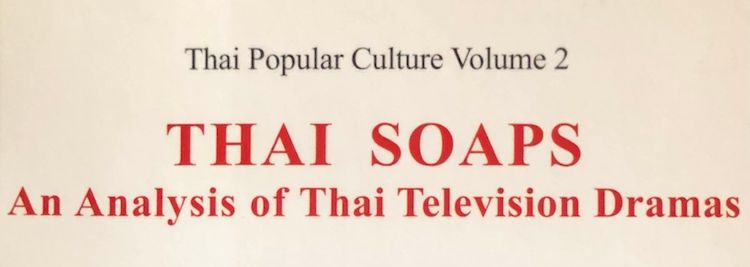
Gerhard Jaiser begins his book Thai Soaps: An Analysis of Thai Television Dramas by distancing himself from “people who appreciate lakhons as entertainment or even as an art form”, admitting that “I myself do not.” Thai soap operas (known as lakhon or lakorn) are justifiably dismissed as nam nao (‘dirty water’), though they still deserve to be analysed, and Thai Soaps is the first book to do so.
Jaiser’s book (published in 2017) begins with a detailed examination of lakorn narrative structure, character archetypes, and other conventions of the genre. The second chapter makes nuanced comparisons between various original series and their modern remakes, helpfully guiding the reader through the sometimes confusing multiplicity of lakorn versions.
A chapter on lakorn and politics notes how censorship is determined by the political climate. For example, the Thaksin Shinawatra satire เหนือเมฆ (‘beyond comparison’) was uncontroversial in 2010 because “at that time, the Democrat Party, favorable to the Yellow Shirts (and to Channel 3), was in power”, whereas its sequel was censored in 2012, when Thaksin’s sister Yingluck was in office. Ing K.’s film Shakespeare Must Die (เชคสเปียร์ต้องตาย) suffered a similar fate for the same reason.
Jaiser is surprisingly uncritical of the deeply problematic representation of minorities in lakorn. He does discuss the asexual nature of gay characters, the increasingly negative stereotyping of Westerners, and the almost total absence of black people, though he doesn’t call this out as homophobic or racist. He even seems reluctant to condemn the reprehensible depiction of rape in lakorn, noting that they portray it as “an act that can even increase the love of the female victim for the rapist” yet criticising this in only mild terms as “questionable”.
Thai Soaps includes a valuable appendix listing major lakorn series, with their Thai titles, plot synopses, and (in most cases) original transmission dates. It’s a good example of not judging a book by its cover—which features a fairly unappealing snapshot—because this is a first-rate study of a second-rate genre.
Jaiser’s book (published in 2017) begins with a detailed examination of lakorn narrative structure, character archetypes, and other conventions of the genre. The second chapter makes nuanced comparisons between various original series and their modern remakes, helpfully guiding the reader through the sometimes confusing multiplicity of lakorn versions.
A chapter on lakorn and politics notes how censorship is determined by the political climate. For example, the Thaksin Shinawatra satire เหนือเมฆ (‘beyond comparison’) was uncontroversial in 2010 because “at that time, the Democrat Party, favorable to the Yellow Shirts (and to Channel 3), was in power”, whereas its sequel was censored in 2012, when Thaksin’s sister Yingluck was in office. Ing K.’s film Shakespeare Must Die (เชคสเปียร์ต้องตาย) suffered a similar fate for the same reason.
Jaiser is surprisingly uncritical of the deeply problematic representation of minorities in lakorn. He does discuss the asexual nature of gay characters, the increasingly negative stereotyping of Westerners, and the almost total absence of black people, though he doesn’t call this out as homophobic or racist. He even seems reluctant to condemn the reprehensible depiction of rape in lakorn, noting that they portray it as “an act that can even increase the love of the female victim for the rapist” yet criticising this in only mild terms as “questionable”.
Thai Soaps includes a valuable appendix listing major lakorn series, with their Thai titles, plot synopses, and (in most cases) original transmission dates. It’s a good example of not judging a book by its cover—which features a fairly unappealing snapshot—because this is a first-rate study of a second-rate genre.
